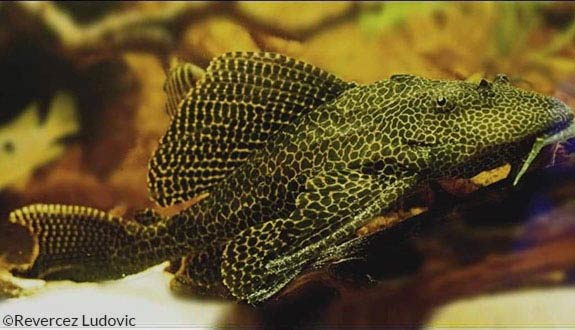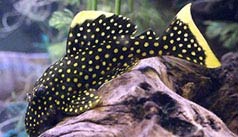

Alternative species (click on the thumbnail to see the card)
Names
Scientific name
Pterygoplichthys gibbiceps
Ancistrus gibbiceps
Glyptoperichthys gibbiceps
Liposarcus altipinnis
Common name
Leopard Pleco
Sail Fin Pleco
Gibby
Leopardplettet Sugemalle
Sejlfinnet Leopardmalle
Waben-Schilderwels
Origin

Origin: South America (Peru, Brazil)
Biotope: Amazonian
Dimorphism

None
Group
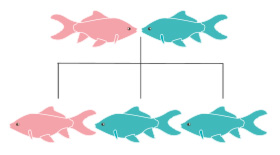
Loricariidae
Volume

800 L / 176 imp gal / 211 US gal
Parameters

T°: 25 to 27°C or 77 to 81°F
pH: 6 to 7
Hardness: 5 to 10°dGH
Difficulty

Easy
Size

35 to 50cm (13.8 to 19.7")
Longevity

15 years
Living zone
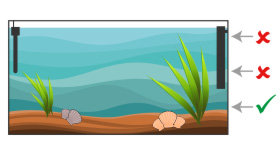
Depth
Individuals
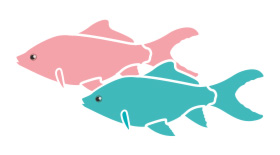
2
Food
How to feed the Leopard Pleco?
Food
How to feed the Leopard Pleco?
Even if the Leopard Ploco is an omnivore, the major part of its diet must be made up of plants, and more precisely of algae. It will find part of its food directly in the aquarium, by scraping the algae from the decor. However, this is unlikely to be enough to satisfy this gentle giant.
For fresh food, offer slices of zucchini or cucumber, boiled peas, poached spinach or salad... These foods should be made available very regularly. The meat part (from time to time) can be provided by the distribution of mussel, fish or shrimp flesh, bloodworms, daphnia, artemia...
Complete with vegetarian or omnivorous groundfish pellets.
As this fish has nocturnal habits, it is better to distribute its meal just after the lights go out.
Behavior
What kind of behavior does the Leopard Pleco have?
Behavior
What kind of behavior does the Leopard Pleco have?
It is very calm and peaceful during the day, spending most of its time stuck to the scenery without moving. King of camouflage, it is sometimes difficult to spot! This natural behaviour is only valid in good maintenance conditions. If it is too cramped in its aquarium, the Pléco can become aggressive.
At night, it is active in its favourite activities: scraping the decor and searching the floor.
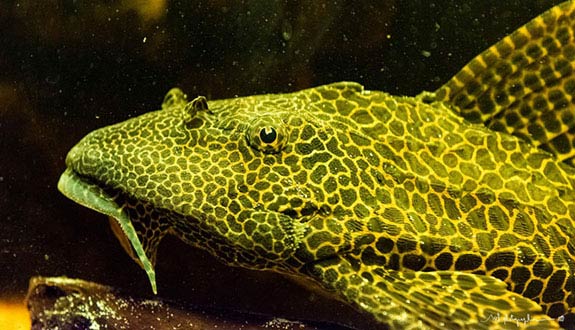
Cohabitation
Who can live with the Leopard Pleco?
Cohabitation
Who can live with the Leopard Pleco?
The Leopard Ploco appreciates the presence of their congeners even if they are territorial. However, some individuals develop an exacerbated territorial character. Thus, you will only be able to keep 2 Leopard Plocoes together in an aquarium of 800 L / 176 imp gal / 211 US gal minimum.
The Pleco is perfectly peaceful towards other species. However, avoid association with other species of territorial groundfish with which the juxtaposition of territories can be problematic. It can easily be associated with Oscars (Astronotus ocellatus) for example.
Breeding
How to breed the Leopard Pleco?
Breeding
How to breed the Leopard Pleco?
Not possible in an aquarium.
Its aquarium
Which aquarium for the Leopard Pleco?
Its aquarium
Which aquarium for the Leopard Pleco?
Generally speaking, the minimum volume for maintaining an individual of this species in good conditions is a 500 litre (110 Imp Gal / 132 US Gal) aquarium. However, it would be preferable to opt for 2 Plecos in an 800 L / 176 imp gal / 211 US gal one. Finally, prefer rather long aquariums, as it is the available floor space that really counts (the height of the aquarium does not matter). For smaller volumes than those mentioned above, prefer to use Ancistrus, which are much smaller.
Plan as many hiding places as there are Plecos, or even more. Indeed, this territorial fish will defend its territory against its fellow fish and everyone must find a place that gives it satisfaction! Form these hiding places by intertwining rocks and roots.
Peat bog roots are indispensable in a Pléco aquarium because this one will take great pleasure in scraping them.
A good filtration will allow to maintain a good water quality (this fish is a big polluter!) and a high level of oxygen, essential for the well-being of this species.
Moreover, note that the Pléco likes the strong current! In these conditions, choose a filtration flow rate at least equal to 10 or 20 times the volume of the aquarium per hour.
As far as the choice of plants is concerned, the Pléco does not touch them, at least not intentionally. But once its adult size is reached, this giant can damage or uproot fine plants with its movements. Choose sturdy plants (Anubias type) that you will fix firmly to the decor or in the ground (with a ballast).
Another point of vigilance: the ground. As the Pleco searches the ground in search of food, it must be non-cutting. Choose a river sand such as Loire sand for example. In some cases (this is not valid with all Plecos), the nutritious substrate should be avoided because the fish digging activity may mix sand/substrate, or even spread it all over your aquarium and make the water cloudy.
Good To know
Find all additional information!
Good To know
Find all additional information!
Its suction cup-shaped mouth allows it to be attached to windows and decor. It scrapes off algae from these surfaces. This is why it is often sold as a "cleaner". Yet, nocturnal, territorial and huge, this fish is poorly adapted to most aquariums!
This species can be confused with those of the genus Hypostomus but Pterygoplichthys gibbiceps has a larger dorsal fin and is slightly larger. Finally, Pterygoplichthys gibbiceps has black spots on an orange background, while Hypostomus plecostomus are usually in shades of grey.
If the water is too polluted, it may have small holes in its fins. This is a symptom of urgent distress! Renew some of the water in the aquarium immediately and review your maintenance schedule.
Its dorsal fin has very sharp spines! It can easily pierce its carrying bag or get stuck in the net (use a plastic box instead). Also be careful when handling it.
Yours photos!
Comments
Sort by:
Please login to post comments
